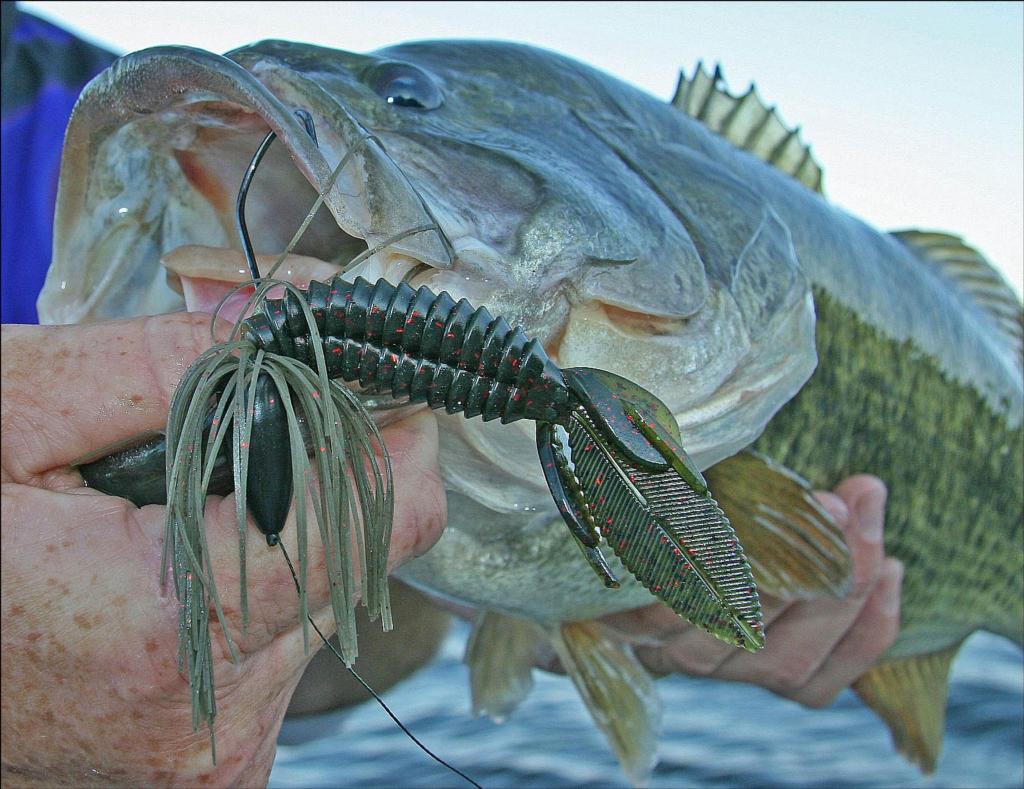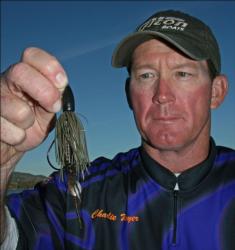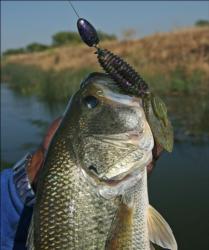Punch drunk
Driving baits through heavy vegetation often yields big-time bites

The notion of “What lies beneath,” can captivate even the most seasoned bass angler when staring at a stretch of matted, clumpy or otherwise largemouth-shielding vegetation. However, while the prospects of catching a behemoth bass hiding under grass mats is enticing to say the least, most savvy anglers know that the real challenge is a technical one – how to reach the hidden quarry with the available equipment on hand?
For reasons soon to come, bass tuck themselves under these soggy salad bars and stubbornly hold their ground. Jiggling the canopy with frogs, buzz toads and weedless-rigged worms may draw those thunderous, weed-whacking strikes of which we fantasize, but the highlight reel stuff is usually restricted to brief periods when the fish feel up to a surface attack. However, when temperature, tide, fishing pressure – or some combination – keeps the fish undercover, the key to winning this fight lies in knowing how to throw a punch.
Pioneered in Florida’s weedy lakes, but applicable coast-to-coast, “punching” draws its name from the brutish action of driving a bait through a dense conglomeration of aquatic plants such as hyacinth, hydrilla, pennywort, milfoil as well as that slimy yellowish-green stuff. With this vegetation either free floating, or anchored by narrow roots, spacious caverns of moderate temperature and shady seclusion offer cozy bass digs below. Harboring baitfish and crawdads, while keeping the area well oxygenated, matted vegetation offers an almost perfect safe haven for largemouth bass.
 Sounds like a righteous little crash pad, right? Indeed, it is. So just imagine the reaction of a largemouth bass – a creature known for its crush-first-ask-questions-later policy – when a brash burglar shatters this sweet solitude. Let’s just say the question of edibility matters little – the intruder must die.
Sounds like a righteous little crash pad, right? Indeed, it is. So just imagine the reaction of a largemouth bass – a creature known for its crush-first-ask-questions-later policy – when a brash burglar shatters this sweet solitude. Let’s just say the question of edibility matters little – the intruder must die.
Past the allure of reaction strikes, Potomac River guide Steve Chaconas said that punching provides a strategic tool. “Punching is an effective tactic for two big reasons: One, it’s where the fish are. Two, it’s where (most of) the fishermen aren’t! Many anglers are intimidated with mat fishing and they pick off the smaller fish on the edges. The bigger fish will be in the mat and a good mat will hold fish just about every day.”
Honing in on the right neighborhood
This one’s simple: If it’s matted, punch it. Some waters retain their mats year-round, while others see most aquatic vegetation dying off in winter. Bottom line, whenever vegetation floats, it will attract bass.
“This is a fairly easy pattern to establish,” Chaconas said. “Once you find fish in one mat, or in a specific location in a mat, than you can duplicate the pattern elsewhere. Mats with deep water or with current or on a point are great.”
 That said, Chaconas notes the grind factor common to punching. “Mat fishing is tough mentally. You have to thoroughly fish a mat, looking for the key spot and punching it like a grid to find those spots. Once you develop a pattern, you can hit only the best spots.”
That said, Chaconas notes the grind factor common to punching. “Mat fishing is tough mentally. You have to thoroughly fish a mat, looking for the key spot and punching it like a grid to find those spots. Once you develop a pattern, you can hit only the best spots.”
Tidal environments, like Chaconas’ Potomac home waters, complicate the game but the rules are actually fairly straightforward – just watch the daily ebb and flow. In the vast California Delta, where punchable mats abound, San Jose angler Chris Zaldain knows that falling water pulls fish away from shallow cover and rising water ushers them back. Punching the right areas at the right tide stage is essential, so Zaldain looks for mats with grassy perimeters where fish can stage on low tide.
“I’ll just follow the tide up to the mats,” Zaldain said. “When the tide is low, I’ll sit in 10-12 feet of water and flip the outside grass lines. Once the tide comes up, I’m flipping anything with a canopy over the fish’s heads and current nearby.”
Zaldain often targets the weed mats that float into marinas and accumulate in empty boat slips. Marinas with entrance and exit canals – as opposed to a single opening – receive better flushing, so the habitat remains well oxygenated. On the other hand, an isolated mat in the back of a small canal could be a one-hit-wonder.
Heavy subject
 If you can tie a Texas rig, you’ll be fine with a punch rig. The difference is an oversized weight – usually tungsten. Orinda, Calif. pro Zack Thompson sometimes uses weights as heavy as 2 1/2 ounces, depending on vegetation density. He said that punching neophytes should understand that, while speed is important, velocity can also be your vexation.
If you can tie a Texas rig, you’ll be fine with a punch rig. The difference is an oversized weight – usually tungsten. Orinda, Calif. pro Zack Thompson sometimes uses weights as heavy as 2 1/2 ounces, depending on vegetation density. He said that punching neophytes should understand that, while speed is important, velocity can also be your vexation.
“The key is to get your bait to fall fast,” Thompson said. “The faster it falls, the more bites you’ll get. But it’s like throwing any other reaction bait – a lot of times the fish will react to the bait but they’re not really trying to eat it, so you’re going to miss some.”
Texas pro Stephen Johnston agrees, noting that when fish suspend under deeper mat scenarios, like the hydrilla beds of Toledo Bend, anglers may be tempted to go lighter, since they don’t need to reach bottom. Nix that thought, Johnston said. Once a bait breaches cover, the hard work is done. Whether the fish have their bellies on the mud or their backs against the weeds, a thick mat is a thick mat and it’s all about making a forced entry.
“If you go too light, you’ll have to fight the bait through the grass,” Johnston said. “What happens is you don’t get that natural fall. The fish can see and feel your bait and you don’t get that reaction strike. It’s better to go too heavy than too light.”
When the fish are super aggressive, ribbontail worms draw plenty of fire, but most of the time, punchers use large profile “creature” baits like Reaction Innovations Sweet Beavers and Strike King Rodents or crawfish imitators such as the Berkley Chigger Craw or the Lake Fork Craw Tube. Straight shank hooks in the 3/0-4/0 range provide the best hook sets – particularly when snelled. Barbs on the shank keep the bait in place and hooks with completely closed eyes prevent braided line from slipping into a gap where it may slide lose or break from abrasion.
 Eliminating the frustration of constantly clearing weeds from his bait, FLW pro Stephen “Bub” Tosh Jr. of Modesto, Calif. invented an accessory to facilitate the technique. Through his Paycheck Baits company Paycheckbaits.com, Tosh produces the Punch Skirt – a ring of hand-tied fibers rigged to a durable bead, which slides onto the line between the hook and weight. The accessory shields a punch bait as it enters and exits the vegetation, while the flaring skirt resembles a moving crawdad.
Eliminating the frustration of constantly clearing weeds from his bait, FLW pro Stephen “Bub” Tosh Jr. of Modesto, Calif. invented an accessory to facilitate the technique. Through his Paycheck Baits company Paycheckbaits.com, Tosh produces the Punch Skirt – a ring of hand-tied fibers rigged to a durable bead, which slides onto the line between the hook and weight. The accessory shields a punch bait as it enters and exits the vegetation, while the flaring skirt resembles a moving crawdad.
FLW co-angler, Hideki Maeda of Sakai City, Osaka-Pref. said the punch skirt really proves its merit on days when creeping tides make the fish inactive. Here, it’s just a numbers game. Somewhere, a decent fish will bite, so Maeda knows the likelihood of a strike increases with his punching diligence.
“I just try to keep punching,” he said. “That’s why I use a Punch Skirt, because it doesn’t pick up grass. I don’t have to take time to remove grass (from my bait) so I can pitch more.”
Gambler also makes a punching accessory called the KO Skirt and do-it-yourselfers can fashion their own, as West Hills, Calif. pro Charlie Weyer demonstrates. Weyer removes the rubber ring from a jig skirt, ties a few overhand knots around the center of the gathered fibers with 65-pound braid, slips his fishing line through the center (with weight positioned on the line) and then tightens the knots. Preferring a streamlined package, Zaldain foregoes a punch skirt, but he rigs a bead above his hook to protect his knot from the heavy tungsten weight.
A couple things that all punchers agree on: First, you’ll need a rubber peg to keep the weight in place. On the front end, the weight makes a hole for the bait, like offensive linemen blocking for a running back. If your weight breaks through the mat and leaves the bait hanging, what’s the point of that? On the back end, a beefy free-roaming weight will often pop the fish’s mouth open on the hook set and all your effort is for naught.
 The other requisite is a stout, 7- to 7 1/2-foot and a sturdy baitcaster loaded with braided line. “You can’t fish the heavy stuff with anything less than 65-pound braid,” Zaldain said. “When you pitch in there and they come at you and you set into them, (the braid) just cuts through the weeds like a knife.”
The other requisite is a stout, 7- to 7 1/2-foot and a sturdy baitcaster loaded with braided line. “You can’t fish the heavy stuff with anything less than 65-pound braid,” Zaldain said. “When you pitch in there and they come at you and you set into them, (the braid) just cuts through the weeds like a knife.”
One thing to consider: Despite the heavy cover and heavy gear, punching actually requires restraint at the moment of truth. Chaconas explains: “Do not snap set! This will pull the big weight right out of the fish’s mouth and given the proximity to the fish, the braided line will yank that (heavy) weight back into your face. Allow the fish to load the rod, bury the butt of the rod in your belly and lean back.”
You’ll often pull a big, nasty wad of weeds up with the fish, but don’t let the lack of movement fool you. A big fish may lie still while heavily weighted, but that won’t last. As Chaconas said, “He’s still very green, just clogged up, so get a good grip.”